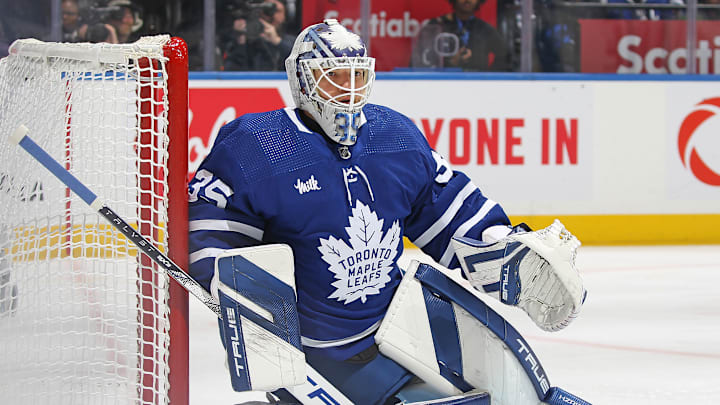The Vegas Golden Knights did it. They acquired a former Toronto Maple Leafs player to bolster a positional need. It's a move that Kelly McCrimmon needed to make, giving them more depth. However, the move isn't the one you're thinking of. If you thought it was Mitch Marner, here's some bad news: He hasn't been moved (yet).
Instead, the Golden Knights signed Ilya Samsonov to a one-year, $1.8 million deal. He'll serve as the backup to Adin Hill alongside Akira Schmid, who was also recently signed. However, Schmid's was a two-year, $1.75 million deal, retaining him from being a restricted free agent. Now, Vegas has goaltending depth to enter the 2024-25 season. If Hill gets hurt again, they have a backup in a goaltender-friendly system.
But let's get back to Samsonov for a second. The former Maple Leafs goaltender had a 2023-24 campaign to forget, posting a GAA of 3.13 and a save percentage of .890. Although he went 23-7-8 last season, he was bolstered by a strong Maple Leafs lineup, led by Auston Matthews.
What can the Russian netminder do to get back to prominence? How will he benefit from playing under Bruce Cassidy's system? Like Victor Olofsson, Samsonov is on a "prove-it" deal. He can improve Vegas with a rebound season, especially as a backup to Adin Hill. Here's how the former Toronto goalie can produce that rebound season.
Ilya Samsonov has goaltender size to his advantage
Standing 6'3" and weighing 200 lbs., Ilya Samsonov is a sizable goaltender. It's a motif embraced by the Vegas Golden Knights recently, with Hill and Logan Thompson coming to mind. In fact, Akira Schmid is another big netminder, standing 6'5". Therefore, Samsonov fits right in.
But that's all the Russian goalie has to his name, for his other aspects need improvement. For example, he tends to bounce his rebounds toward the opposition, providing juicy opportunities to score. He also doesn't have a good reaction to incoming shots. Take the first game in the Stanley Cup playoffs against the Boston Bruins as an example:
There are times where he could simply swallow up and ice the puck (such as Boston's fourth goal). However, he bounced the rebound toward incoming Bruins players, leaving Jake DeBrusk to capitalize for a power play goal. With Pacific Division rivals boasting players such as Leon Draisaitl and Elias Pettersson, that could become problematic.
Therefore, Samsonov must do two things with the Vegas Golden Knights. First, he must use his big frame more and swallow pucks. That means not playing low and staying upright. Second, he must be better at bouncing rebounds to his teammates. Luckily, the Golden Knights have the perfect system for him to thrive.
The Vegas Golden Knights are more defensive-minded than the Toronto Maple Leafs
The Golden Knights might not be offensively apt like the Toronto Maple Leafs. While they have Jack Eichel, Toronto boasts players such as Auston Matthews, William Nylander, and Mitch Marner. However, Vegas does have a solid blue line that does everything right. It doesn't matter if it's successful exits or having a player in front of the net. Bruce Cassidy makes it imperative to keep the puck away from the goaltender and control the tempo.
That's part of why the Toronto Maple Leafs lost to the Boston Bruins. The Bruins made a living off putting a bigger body in front of Ilya Samsonov, leaving him looking for the puck. Vegas has a bigger team than the Maple Leafs, with an average height of 74.1 inches (Toronto averages 73.1). That's the same thing weight-wise, where Vegas averages 207.9 lbs. (Toronto averages 202).
With Vegas emphasizing redirecting offenses and taking away shooting lanes, goaltenders have an easier time with Bruce Cassidy's system. Adin Hill and Logan Thompson are shining examples of this, getting some room to breathe in net. That's what awaits Samsonov this upcoming season, where he can rebound to his 2022-23 numbers (GAA of 2.33, save percentage of .919, four shutouts).
